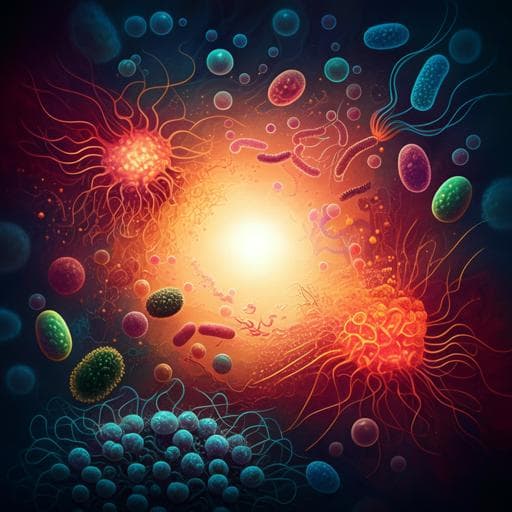
Medicine and Health
Sexual behavior is linked to changes in gut microbiome and systemic inflammation that lead to HIV-1 infection in men who have sex with men
H. Lin, Y. Chen, et al.
This groundbreaking research explores how sexual behavior influences gut microbiome health, systemic inflammation, and the risk of HIV-1 infection among men who have sex with men. Conducted by a team of experts including Huang Lin, Yue Chen, and others, it reveals that unprotected receptive intercourse is linked to heightened inflammatory responses and altered gut microbiota before HIV-1 infection occurs.
~3 min • Beginner • English
Introduction
Sexual contact among men who have sex with men (MSM) remains the predominant mode of HIV-1 transmission in the United States. Receptive anal intercourse carries the highest transmission risk, partly due to the presence and activation of CCR5+ CD4+ T cells in gut-associated lymphoid tissue (GALT), which are prime targets for HIV-1. Gut microbiome dysbiosis can heighten local inflammation, promote immune activation, and facilitate microbial translocation into circulation, contributing to systemic inflammation and increased susceptibility to infection upon exposure. The study aims to investigate how self-reported sexual behaviors (number of receptive anal intercourse partners) among MSM relate to systemic inflammatory cytokines and gut microbiome profiles before HIV-1 infection, and whether cytokines and microbiota mediate the relationship between sexual behavior and subsequent HIV-1 infection.
Literature Review
Prior work shows MSM (regardless of serostatus) have Prevotella-rich fecal and rectal mucosal microbiomes and rectal mucosal immune activation profiles compared to men who have sex with women. The authors’ prior analysis in the MACS cohort (1984–1985) found elevated plasma inflammatory cytokines and a gut microbiome characterized by increased Prevotella and decreased Bacteroides months before seroconversion, correlating with higher odds of primary HIV-1 infection. These findings were corroborated in non-MACS cohorts (2014–2018). Despite these observations, interactions among sexual behavior, cytokine biomarker levels, gut microbiome, and subsequent HIV-1 infection had not been comprehensively evaluated, motivating the current mediation-focused analysis.
Methodology
Study design and participants: Case-control analysis within the Multicenter AIDS Cohort Study (MACS), a prospective cohort of MSM initiated in 1983 across multiple U.S. sites. The analytic dataset included 160 HIV-1 infected participants (cases) and 156 HIV-1-negative controls. Visits were semiannual with interviews, exams, and biospecimen collection; HIV-1 serostatus and RNA were retrospectively determined from stored plasma. For seroconverters, pre-infection (HIV Ab–/RNA–) and post-infection (RNA+) visits were stringently selected; controls had both visits HIV Ab–/RNA–. The midpoint between the last negative and first positive visit (≈3 months after the pre-infection visit) was used as the estimated infection date.
Exposure: Sexual exposure groups based on the number of partners with whom the participant had receptive anal intercourse over the prior two years. Primary categorization into ordered groups (G1–G4); a sensitivity analysis used a five-level grouping (G1–G5) with finer partner counts.
Covariates and potential confounders: Demographics, education, smoking, alcohol, antibiotic use, STI history, substance use, HBV/HCV status. Substance use was identified as a confounder between sexual exposure and infection; antibiotic use was modeled as a covariate affecting biomarkers rather than infection directly.
Cytokine measurements: Plasma sCD14, sCD163, IL-6, LBP, and CRP were assessed. Trends across sexual exposure groups were tested using constrained inference (CLME) models to evaluate monotonic relationships and pairwise contrasts.
Microbiome profiling: Stool DNA underwent 16S rRNA V4 amplicon sequencing (Illumina MiSeq) using primers 515F/806R. QIIME2 (v2021.10) with DADA2 generated ASVs; taxonomy was assigned with a trained classifier. No ASVs were filtered by abundance. Alpha diversity (richness, Shannon) and beta diversity (Bray–Curtis with PERMANOVA) were analyzed. Differential abundance and monotonic trend analyses across exposure groups and by HIV-1 infection status were conducted with ANCOM-BC2, using prevalence and library size filters (prevalence ≥10%, library size ≥1000). Multiple testing used Benjamini–Yekutieli adjustment. Pairwise Pearson correlations among taxa were estimated via sparse correlation methods to assess network changes.
Association analyses: Examined associations of sexual exposure groups with cytokines and microbiome (alpha/beta diversity and taxa). Differential abundance between HIV-1 infected and uninfected participants identified taxa associated with outcome.
Mediation analyses: To assess whether cytokines and microbiota mediate the relationship between sexual exposure and HIV-1 infection, Natural Effect Models (imputation-based approach) were implemented using the medflex R package. Multiple-mediator models were fit for: (1) cytokines (sCD14, sCD163), (2) selected microbial taxa associated with both exposure and outcome (Akkermansia muciniphila, Bacteroides caccae, Bacteroides fragilis, Bacteroides uniformis, Bacteroides spp., Butyricimonas spp., Dehalobacterium spp., Methanobrevibacter spp., Odoribacter spp.), and (3) combined cytokine and microbial mediators. Natural direct effects (NDE) and natural indirect effects (NIE) were estimated with robust standard errors; monotonic trend tests across exposure groups were performed. Substance use was included as a confounder in mediation models.
Sensitivity analysis: An alternative five-level exposure categorization (G1–G5) yielded results congruent with the primary four-level categorization, supporting robustness of findings.
Data availability: Processed data are available via a GitHub repository; raw sequencing data are available upon request per MWCCS policy.
Key Findings
- HIV-1 infection risk increased monotonically with the number of receptive anal intercourse partners over the prior two years (p < 0.001). Recreational substance use was positively associated with both number of receptive partners (p < 0.01) and HIV-1 infection (p = 0.02). Antibiotic usage was associated with sexual exposure groups (p = 0.03) and HIV-1 infection (p = 0.01).
- Cytokines: sCD14 levels showed a significant increasing trend across sexual exposure groups (p = 0.014). CRP showed a marginally significant increase (p = 0.03). sCD163 exhibited a marginally significant trend (p = 0.068).
- Microbiome diversity: No significant associations were observed between sexual exposure groups and alpha diversity (richness, Shannon) under monotonic increasing or decreasing trends; no significant differences in beta diversity by Bray–Curtis at the species level.
- Differential microbial abundance patterns: Higher sexual exposure groups and HIV-1 infected participants exhibited reduced abundances of beneficial taxa including Akkermansia muciniphila, Bacteroides caccae, Bacteroides fragilis, Bacteroides uniformis, Bacteroides spp., Butyricimonas spp., and Odoribacter spp. Potential increases were observed for Dehalobacterium spp. and Methanobrevibacter spp. in future HIV-1 infection relative to uninfected participants. Pairwise correlations among taxa decreased with higher exposure, with many estimates near zero in the highest exposure group, suggesting dysbiosis.
- Mediation analyses (Natural Effect Models):
• Cytokines (sCD14, sCD163) as mediators: Significant NDEs of sexual exposure on HIV-1 infection with monotonic trend p < 0.001; log-odds ratios (LOR) for NDE increased across groups (e.g., G2–G1 LOR 1.92, p = 0.003; G3–G1 LOR 2.56, p = 0.001; G4–G1 LOR 3.55, p < 0.001). NIEs showed smaller effects; some contrasts reached significance (e.g., G4–G1 NIE p = 0.023).
• Microbial taxa as mediators: Significant NDE associated with microbial abundance (trend p = 0.033), with increased odds of infection when shifting microbial profiles from G1 to G4 while holding exposure constant (reported OR ≈ 1.95). NIEs were generally modest.
• Combined cytokine and microbial mediators: Joint model yielded NDEs similar in direction and magnitude to separate models (e.g., G2–G1 LOR 1.81, p = 0.005; G3–G1 LOR 2.38, p = 0.001; G4–G1 LOR 3.16, p = 0.001). Combined NIEs were larger than those from cytokines or microbiota alone (e.g., G4–G1 NIE LOR 0.74, p = 0.002), indicating that together, cytokines and microbiota significantly mediate the effect of sexual exposure on HIV-1 infection.
- Overall, biomarkers (sCD14, sCD163) and specific microbial taxa collectively mediated the effect of sexual behavior on HIV-1 infection risk; individually, most mediators showed limited indirect effects.
Discussion
The study reveals an interconnected pathway linking high-risk sexual behavior among MSM to gut microbiome dysbiosis and systemic inflammation that precede and likely promote HIV-1 infection. A higher number of receptive anal intercourse partners was associated with monotonic increases in sCD14 (and marginally in CRP, sCD163), suggesting heightened mucosal inflammation and microbial translocation. Concomitantly, key commensals involved in mucosal integrity and immune homeostasis (e.g., Akkermansia muciniphila, Bacteroides uniformis, B. fragilis, Butyricimonas, Odoribacter) were reduced in higher exposure groups and among HIV-1 infected participants, while certain archaeal/bacterial taxa (e.g., Methanobrevibacter, Dehalobacterium) showed potential increases. The weakening of microbial co-occurrence correlations with higher exposure supports a dysbiosis phenotype. Mediation analyses indicate that cytokines and microbial composition significantly transmit the effect of sexual exposure on HIV-1 infection, with appreciable natural direct effects and modest but significant joint indirect effects. These findings integrate behavioral risk with biological susceptibility mechanisms, emphasizing that condomless receptive intercourse may prime rectal/GALT tissues via inflammation and microbiome alterations, thereby increasing the probability of systemic infection upon exposure to HIV-1. Substance use was associated with both exposure and outcome and was accounted for as a confounder in mediation models, though its potential mediating role appeared limited in this dataset.
Conclusion
This work demonstrates that among MSM, the number of receptive anal intercourse partners is linked to pre-infection increases in systemic inflammatory markers and to gut microbiome dysbiosis characterized by reductions in beneficial taxa. Cytokines (sCD14, sCD163) and specific microbial taxa jointly mediate the effect of sexual behavior on HIV-1 infection risk. These insights bridge behavior, immune activation, and microbiota in HIV-1 susceptibility and underscore the potential of microbiome- and inflammation-targeted strategies alongside behavioral and biomedical prevention. Future research should employ comprehensive causal frameworks and advanced high-dimensional mediation methods, integrate longitudinal multi-omics with mucosal immunology, and evaluate the impacts of contemporary prevention modalities (e.g., PrEP) and antibiotics on the rectal/gut microbiome and inflammation in modern MSM cohorts.
Limitations
- Single stool specimen per participant may not capture day-to-day microbiome variability, introducing sampling variability and potential bias.
- Data are from the early AIDS epidemic (mid-1980s), prior to current prevention practices (condoms, PrEP/PEP), potentially limiting generalizability to contemporary settings.
- Some exposure and behavioral data are self-reported, which could introduce misclassification.
- Mediation analysis required dimensionality reduction of high-dimensional compositional microbiome data, potentially omitting relevant taxa and limiting causal inference; high-dimensional mediation methods with available software are still evolving.
- Certain groups (e.g., high partner counts, STI/HIV status subgroups) had smaller sample sizes for specific analyses, reducing power.
- Antibiotic usage and substance use complicate interpretation; while modeled appropriately (covariate/confounder), residual confounding remains possible.
- Raw sequencing data are not publicly available (available upon request), which may limit external reproducibility.
Related Publications
Explore these studies to deepen your understanding of the subject.







